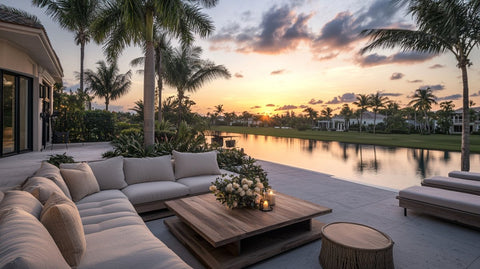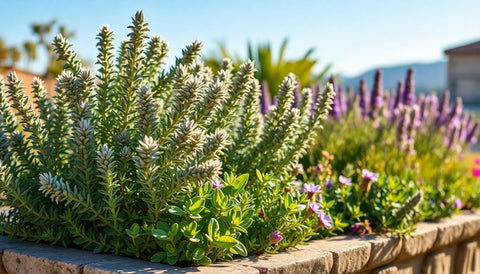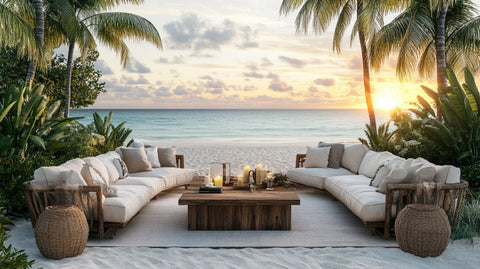Introduction: Captivating the Reader
South Florida is a region marked by its stunning natural beauty, a paradise where the lush and vibrant landscape plays an essential role in defining its character. The unique blend of tropical weather, diverse wildlife, and vital ecosystems make it an intriguing subject for anyone interested in nature, ecology, and horticulture. Landscape design here is not just an aesthetic pursuit; it is a vital component of the ecological framework that supports the rich tapestry of life in this part of the world. This blog post will explore the diverse and vibrant landscape of South Florida, underscoring its ecological and cultural significance while offering insights into how you can recreate a piece of this natural wonder in your own space.
The Unique Climate and Geography of South Florida

Overview of South Florida’s Tropical Climate
South Florida enjoys a tropical climate characterized by its warm temperatures and high humidity levels throughout the year. With an average temperature ranging from 60°F in the cooler months to 90°F during the peak of summer, it provides a perfect environment for a wide variety of plant species. The region is blessed with abundant sunshine, which supports a robust growth cycle for many exotic plants.
Impact of Geography on the Landscape
Geographically, South Florida is defined by its peninsular location as it is nestled between the Atlantic Ocean and the Gulf of Mexico. This unique placement influences the biodiversity of the region. The Everglades, Florida Keys, and numerous national parks contribute to its complex landscape. The region is naturally inclined to support plants that thrive in sandy, well-draining soil, a perfect canvas for tropical and subtropical flora.
Key Landscape Features of South Florida
The Everglades: An Ecosystem Like No Other
The Everglades is a vast natural region of tropical wetlands and possibly the most prominent landscape feature in South Florida. This ecosystem serves as a critical source of water for numerous species, including humans. It hosts a diverse range of flora and fauna, such as the iconic sawgrass meadows, mangrove forests, and hardwood hammocks. Designing a landscape inspired by the Everglades means prioritizing biodiversity and water management through the use of native plants.
Beaches and Coastal Scenery
South Florida’s coastline features soft, sandy beaches complemented by palm trees swaying in the ocean breeze. The beaches are home to resilient plant species adapted to salty air and sandy soil. The Adonidia Palm, also known as the Christmas Palm, is a popular choice for those looking to mirror this serene coastal vibe in their landscape. Its elegant look adds a tropical flair that embodies South Florida's coastal charm.
Urban Oasis: Miami’s Green Spaces
Miami has managed to merge urban living with expansive green spaces, demonstrating how landscape design integrates into the urban fabric. Parks, gardens, and street plantings comprise Miami’s urban oasis, offering city-dwellers a breath of fresh air amidst high rises. The presence of plant species such as the Alexander Palm provides shade and enhances the ecological benefits of these areas by supporting local wildlife.

Popular Plant Varieties in South Florida Landscaping
Palms: The Signature Plant of South Florida
The Adonidia Palm
Known for their easy maintenance and striking appearance, palms are ubiquitous in South Florida landscapes. The Adonidia Palm is prized for its slender trunk and beautiful fronds and comes in various options, including single, double, and triple formations to suit any garden or landscape size.
Flowering Plants: Adding Color and Fragrance
Agapanthus Lily of the Nile
For a touch of color, the Agapanthus Lily of the Nile is a favorite among gardeners. This plant produces beautiful blue flowers that add an exotic appearance to gardens while being relatively low maintenance. Perfect for planting along pathways or in garden beds, these blooms are a stunning complement to the greenery.
Succulents and Cacti: The Drought-Tolerant Beauties
Agave Varieties
With water conservation becoming increasingly important, succulents and cacti offer an excellent solution for drought-prone areas. The Blue Agave, Caribbean Agave, and Desmettiana Variegata are among the hardy and visually striking options available for South Florida landscaping. These plants stand out with their sculptural forms and varied textures.
Designing a Resilient South Florida Landscape
Principles of Sustainable Landscaping
Creating a resilient South Florida landscape involves techniques that enhance the adaptability and sustainability of the region’s plant life. By choosing native plants, one can reduce the need for excessive irrigation and chemical fertilizers. Moreover, incorporating native and drought-tolerant species helps maintain biodiversity and support local wildlife.
Utilizing Native Plants
Native plants are well-suited to local climate conditions, requiring less water, fertilizer, and overall maintenance. The use of plants like Aglaonema Silver Bay in interiors also affects the exterior seamlessly by promoting air quality and a more harmonious transition between indoor and outdoor living spaces.
Emphasizing Water Conservation
Water conservation techniques are vital when designing a South Florida landscape, where dry seasons can stress plant life. Consider using drip irrigation systems that minimize water loss and create rain gardens to manage stormwater. These gardens utilize topographic depressions to collect rainwater, which plants then absorb, thus reducing water runoff.

Cultural Significance and Heritage of South Florida Landscapes
Influence of Indigenous Practices
The indigenous tribes of South Florida, such as the Seminole and Miccosukee, have long respected the land's natural rhythms and resources. Understanding and incorporating traditional knowledge and indigenous plants into modern landscaping fosters a deeper connection to the region’s rich heritage and contributes to environmentally responsible design.
Impact of Immigrant Cultures
South Florida’s diverse population has influenced its landscape design significantly. Caribbean, Latin American, and European immigrants have brought their horticultural practices and plant preferences, integrating them into the local environment. The mixing of these cultural styles creates distinctive gardens that celebrate both diversity and community.
Transform Your Space with Plantology
At Plantology, we are passionate about providing plants that help you bring a piece of South Florida’s vibrant landscape into your own environment. Whether you're looking to add a tropical feel with palms or enhance your garden with succulent beauty, we have a wide selection that caters to your landscaping aspirations.
Visit our website to explore our full range of offerings and find the perfect plants to transform your outdoor or indoor space.
Conclusion: Embracing South Florida’s Landscape
The South Florida landscape is a dynamic and diverse tapestry woven from its unique climate, geographical features, and cultural influences. In creating a lush and vibrant garden or landscape, incorporating native plants not only enhances beauty and resilience but also supports the ecological balance essential to this region. By appreciating the intricate connections between climate, geography, and culture, we can all contribute to preserving and celebrating the natural beauty of South Florida.
For those inspired to incorporate elements of the South Florida landscape into their own spaces, remember that Plantology is your partner in horticultural excellence. Let us help you plant a greener future by introducing you to plants that resonate with the aesthetic and ecological value of South Florida.
Discover more at Plantology and start designing your dream landscape today.
``` This article comprises well-organized content on South Florida landscape design from the perspective of Plantology, integrating product links and calls to action where appropriate. ```htmlExploring the Gardens of South Florida

Vizcaya Museum and Gardens
One of the most breathtaking examples of landscape architecture in South Florida is the Vizcaya Museum and Gardens in Miami. This historic estate, built in the early 20th century, offers a perfect blend of European design and the lushness of South Florida's natural setting. The formal gardens are inspired by Italian and French aesthetics but adapted to withstand the tropical climate, incorporating native plants and architectural elements that mitigate the effects of heat and humidity.
Vizcaya’s shaded pergolas, mangrove-covered shorelines, and the extensive use of indigenous materials in garden features offer lessons in blending international design inspirations with local ecology. Visitors are treated to an impressive display of orchids and bromeliads, which thrive in Miami’s welcoming conditions.
Fairchild Tropical Botanic Garden
Fairchild Tropical Botanic Garden is another iconic landscape, celebrating South Florida’s potential for botanical glory. This 83-acre garden in Coral Gables is dedicated to the conservation and exhibition of tropical plants, housing one of the largest collections in the country. It highlights the marriage of horticulture and conservation with its dynamic design that emphasizes sustainability.
The garden's extensive plant collections include palms, cycads, flowering trees, and vines, all carefully integrated within a stunning landscape. It is also home to innovative programs such as the Million Orchid Project, aimed at reintroduction of native orchids into urban spaces. The success of such an ambitious endeavor serves as inspiration for utilitarian landscape practices in the face of urban expansion.
Incorporating South Florida Style in Your Own Yard
Choosing Plants that Thrive
When designing your yard to reflect South Florida’s landscapes, it is crucial to consider plant species that complement the local climate. For a touch of elegance and sustainability, focus on native plants or those well-suited to tropical conditions. For example, the Lipstick Plant offers beautiful blooms and a pop of color to any garden area.
Creating Shade with Trees
Shading elements in your garden not only provide relief from the heat but also support plant diversity. Consider planting trees like the native South Florida Slash Pine for structural impact. These trees add significant ecological value by providing habitat for birds and insects, and their fallen needles form a natural mulch layer, reducing water evaporation from the soil.
Introducing Water Features
Water features can capture the essence of a South Florida landscape, where aquatic ecosystems play a crucial role. Reflect the Everglades’ beauty by incorporating small ponds or cascading waterfall features into your garden. This creates a serene environment and attracts local fauna like frogs and dragonflies, contributing to a thriving mini-ecosystem.

Design Principles from South Florida Landscaping
- Layering and Diversity: Emulate the natural density found in South Florida's landscapes by layering plants at different heights. From grand palm trees to lush understory shrubs, this diversity aids in creating microclimates and habitat variety.
- Soft Edges: Instead of rigid, constructed borders, encourage soft edges where plant life meets hardscapes. This mimics the seamless transition between different ecosystems in wild Florida.
- Colorful Contrasts: Utilize the natural palette of vibrant greens, blues, yellows, and more found in indigenous flora to add an artistic quality to your garden.
Learning from South Florida’s Past to Shape the Future
Preserving Biodiversity in Urban Landscapes
Incorporating history into modern landscape design involves acknowledging the region's ecological legacies and its cultural landscape. The rapid development of urban areas, while unavoidable, can harmonize with preservation efforts of vital natural habitats.
Sustainable development practices—such as the integration of green roofs, vertical gardens, and ensuring space for urban wildlife—underscore that urban landscapes can flourish alongside nature rather than detract from it. Initiatives inspired by the layouts of places like the Miami-Dade County’s Eco-Streets emphasize balance, protecting native ecosystems amid urban growth.
Educating Future Generations
Education plays an essential role in this blend of old and new, where programs in schools focus on teaching students about native species and their life cycles, as well as the importance of ecological balance. Excursions to local nature reserves and public gardens encourage appreciation and understanding from a young age, fostering a culture of conservation and respect for the environment.
The Influence of Art in South Florida Gardens
Sculpture and Art Installations
Art plays a pivotal role in South Florida’s landscapes, echoing the region's vibrant cultural scene. From large-scale outdoor sculptures to intricate mosaics, art adds an interactive and emotional dimension to gardens. The Miami Beach Botanical Garden showcases a variety of art installations that blend seamlessly with plant life, offering visitors an immersive experience merging creativity with nature.
Reimagining Spaces with Creative Design
Unconventional garden pathways, whimsical structures, and tactile art pieces throughout South Florida gardens invite visitors to engage with their surroundings. This melding of art and nature reflects the region's diverse cultural tapestry, encouraging expression through plant-based art forms and eco-friendly materials.

Visiting South Florida’s Iconic Landscapes
Famous Parks and Nature Reserves
Discover an array of stunning parks and nature reserves such as the Big Cypress National Preserve and Biscayne National Park. These areas are both recreational havens and hubs of biodiversity, providing the opportunity to observe Florida’s unique wildlife and striking landscapes.
Explore interpretive trails with boardwalks over marshlands, offering direct immersion into the flora and fauna of this vibrant region. Ranger-led tours and educational programs offer a deeper understanding of conservation efforts and highlight the significance of preserving these natural landscapes for future generations.
Access to the Florida Keys
While exploring South Florida’s landscape, a journey to the iconic Florida Keys can provide insights into another unique ecosystem. The Keys’ surrounding coral reefs offer snorkeling and diving adventures, revealing the underwater world and its connection to coastal waters. Conservation and community initiatives, like coral restoration projects, underscore the importance of protecting these delicate marine landscapes.
Recreate South Florida’s Vital Landscape Elsewhere
Climate-Adaptive Strategies
For those outside the tropical climate, adapting South Florida's landscape style involves selecting hardier plant varieties and modifying techniques to suit cooler regions. Cold-hardy succulents, ornamental grasses, and selectively chosen perennials can evoke the lush aesthetics without compromising plant integrity.
Cultural Sensitivity in Global Gardens
The cultural roots influencing South Florida’s landscapes can inspire thoughtful integrations globally. Emulating this approach involves respecting native flora and cultural heritage, ensuring that landscape designs resonate with local identities while fostering international influences. This leads to globally relevant gardens that celebrate points of intersection within diverse plant and cultural spectrums.

Conclusion: Embrace the Dynamic Landscape of South Florida
The Wealth of inspiration drawn from South Florida’s landscapes provides endless possibilities for innovation in garden and landscape design. By focusing on ecological principles, cultural history, and artistic fusion, landscapes everywhere can evolve into spaces of beauty and sustainability.
Whether you are looking to mirror the South Florida style at home or draw from its principles to shape your green space, remember that Plantology is here to assist you. From plant experts to design consultations, we offer a variety of resources to help actualize your vision in vibrant, sustainable, and ecocentric forms.
For more information or to start your transformation journey, visit Plantology today and let us guide you in your quest to create a landscape that embodies the spirit of South Florida and beyond.
```





























Comments (0)
There are no comments for this article. Be the first one to leave a message!